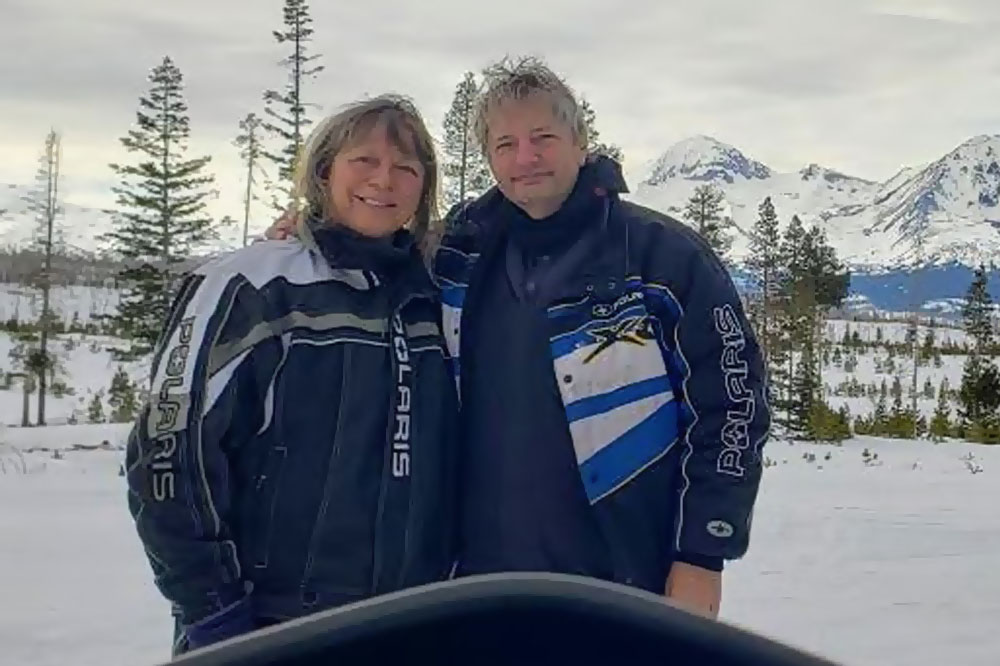
BRAD SIDWELL
An Enlightening Story of Perseverance and Never Giving Up Hope
Written By Julia Brabant
February 2022
Diagnosed: October 2019
Status: Undergoing Ongoing Immunotherapy Treatment
Despite Being Misdiagnosed and A Long Series of Set Backs, Brad Finally Found The Right Doctor
Every pancreatic cancer patient responds differently to chemotherapy, radiation and other potential treatment methods, and what performs poorly in one patient may turn the tables for another. Brad Sidwell’s case is a prime example of this, and while he’s faced setback after setback since his 2019 diagnosis, he’s now seeing a bright future for the first time in years.
When Brad began experiencing severe back pain during a fishing trip in the summer of 2019, he figured it was old issues flaring up again, as he had a history of back problems and surgeries. When his pain progressed, he went to his doctor, who prescribed pain pills, steroid packs and anti-inflammatories. He was flat on his back and even getting into the doctor’s office was a challenge.
By mid-July, Brad began feeling a burning sensation in his stomach. His back pain also worsened, and he went back to the doctor, who administered steroid shots. The shots didn’t help, and Brad had another back surgery at the end of August. After the effects of the post-surgery pain pills wore off, Brad realized the medication had been masking more severe pain in his stomach. He thought it might be the result of an ulcer. His blood work looked pretty good, but his glucose and liver enzymes were slightly elevated. It didn’t seem to be a concern to his doctor at the time.
He again sought medical treatment near his home in southwestern Washington. Doctors tried to perform an endoscopy but were unable to get the camera through his digestive tract. They prescribed Prilosec, which helps decrease the amount of acid the stomach produces. When Brad’s condition continued to worsen, he again called his doctor, who said he’d done everything he could and recommended Brad go elsewhere for a more advanced endoscopy.
Brad did so with his wife, Debbie, by his side. He had another endoscopy at a different facility that finally gave him the answers he’d sought a couple months before – he had pancreatic cancer, and an ulcer, too. His doctor directed him to an oncologist in Vancouver, Washington, but he was unable to get on the schedule there within a reasonable time frame.
Brad and Debbie planned to head back to the Pacific Northwest after hearing that news, but he had bleeds that sent him to the emergency department twice. His ulcerated tumor was an oozing mess that couldn’t be cauterized. There was no treatment except to stop eating to settle things down and stop the bleeding. The second bleed and ED visit happened as they were just beginning the 17-hour drive home. They took it as a sign they were meant to stay. They listened and stayed in Arizona for treatment.
Initially set to begin chemotherapy in early December, 2019, Brad’s condition worsened around Thanksgiving. He developed jaundice, or yellowing on the skin and eyes, due to a blockage in his liver bile duct from the tumor growing and pushing on the liver. He went to the emergency room again. While in the ER, the doctor on duty came in and said, “I’ve reviewed your case, and I would suggest you get your affairs in order.” Doctors installed a bile duct stent to relieve symptoms. Brad was also diagnosed with diabetes, as the pancreas was not working properly to create the insulin and digestive enzymes he needed, which is common in pancreatic cancer cases.
This delayed the start of chemo until mid-December, at which point Brad began an aggressive chemotherapy regimen involving four types of drugs. He responded well at first, seeing considerable tumor shrinkage. Subsequent tests showed that the chemo was becoming less effective over time and he was having more side effects and numbness in hands and feet, which is not uncommon. At this point, they stopped chemo and Brad began about a month of radiation.
His doctor had said that if he could get his CA 19-9 blood test levels under 75, they might be able to think about surgery after all. CA 19-9 tracks the amount of a certain protein in the blood, and it’s used to show if cancer is trending up or down. Eventually, he got to that range, but then his doctor delivered another blow – the surgeon now wanted to see the CA 19-9 to be “normalized” below 35 before they would consider surgery. After radiation, the tumor went “quiet,” but Brad wasn’t eligible for surgery yet.
So, Brad resumed chemotherapy using medications his team hoped would be more tolerable. He’d struggled quite a bit with chemo-related side effects the first time around. He didn’t respond well to the new treatment, and they waited for a couple months for his “number” to come down. Scans showed no new spread, but you don’t want to delay treatment for long with this cancer. His oncologist suggested Brad meet with other surgeons to see if they might feel comfortable moving forward with a Whipple procedure. The Whipple is an intensive surgical operation performed on pancreatic cancer patients if they can get to surgery.
Debbie continued researching facilities and care teams on her husband’s behalf and, ultimately, found a surgeon in Arizona who was very experienced in doing Whipple Procedures. After reviewing Brad’s case and getting new scans showing no spread, he agreed to perform the procedure.
After a rest break so Brad could build up his strength, doctors began the Whipple in February 2021. However, after removing Brad’s gallbladder, doctors found that his cancer had spread to his liver even though it had not shown up on scans. Unable to move forward with the Whipple, they took samples of the tumor for testing and closed him up. He was now Stage 4.
It was a gut punch and very defeating to wake up to find the cancer had spread and that his chance at surgery wouldn’t happen. He’d been given a 20% chance of getting to surgery and finally made it only to have it pulled away. He just wanted to heal from surgery and go home. His doctor expected a few days in the hospital, but the next two weeks were brutal. Brad had internal bleeding, a complete lack of appetite and his digestive track didn’t want to wake up, among other surgery-related side effects. After he got out of the hospital, he ended up in the emergency department twice.
The first time was for a lung embolism that requires long-term blood thinner. He still couldn’t eat more than a few bites at a time and his condition continued to worsen until a second ED visit. Finally, an endoscopy showed that his stomach had collapsed, leading doctors to install a stomach stent. He had dropped about 40 pounds in six weeks, and the stomach stent finally allowed him to eat and recover from surgery. He wanted to look into clinical trials, but he couldn’t start until he was released from effects of the surgery.
Brad wound up enrolling in a clinical trial through BioNTech, where he’d receive infusions of MVT-5873, an antibody therapeutic, while being closely monitored by his care team. Infusion days were long, usually about 8 hours with frequent follow-ups.
A COVID-19 diagnosis threw a wrench in those plans, though, and Brad had to cease participating in the trial for 30 days. He soon started up again and saw slight improvement. He was able to exercise for the first time since his diagnosis, although he tired quickly. He began doing water exercises, using the treadmill and was feeling a bit more like himself until his next hurdle: a major stroke.
Doctors told Brad he was lucky because of where the stroke occurred – because it was closer to the top of his head, he didn’t experience slurred speech or similar complications in the aftermath. His stroke did result in his removal from the clinical trial, though – leading his care team back to the drawing board.
Genome sequencing gave Brad’s team a better sense of how to attack his cancer. It indicated high Microsatellite Instability (MSI), a high Tumor Mutational Burden (TMB) of 28 mut/Mb, and his Mismatch Repair Status was deficient. It showed results with therapy associations, relevant biomarkers, and what drugs and clinical trials might work against all of the things they found and what would not work.
Dr. Borazanci decided to move forward with immunotherapy as the report showed the cancer secretes a high amount of PDL-1 that could be attacked. Immunotherapy boosts the immune system to help it recognize cells that are secreting PDL-1, or whatever is targeted, and allows his own body to fight the cancer. OPDIVO + YERVOY were the chosen treatment plan.
“Dr. B. saved my life – there’s no doubt about it,” Brad said. “If it wasn’t for him and his team, I’m positive I wouldn’t be alive.”
For now, the plan is for Brad to continue immunotherapy treatments for the foreseeable future. Brad now has his diabetes under control. He also takes Creon pills to replace the digestive enzymes his pancreas no longer produces, and still takes blood thinner injections daily. Overall, he’s feeling well and living more and more of a normal life.
He and his wife are avid snowmobilers, and, with Brad’s condition improving, they’ve been able to get back out on the trails and experience God’s winter beauty again. Debbie also talked Brad out of selling a boat he’d bought shortly before his diagnosis – a boat he, at one point, didn’t think he’d be able to use again. Happily, they anticipate salmon fishing this summer. Brad, finally able to enjoy retirement, also spends his days renovating a vacation home in Oregon.
For Brad, finding and starting the immunotherapy treatments have made a world of difference, and particularly when ongoing challenges relating to chemotherapy and surgery had him wondering how much more he could take.
“Once surgery is off the table, you have to look at other options,” he said. “Dr. B’s team – they showed me there’s a lot of hope – and options,” Brad said. “There’s always something to latch onto for hope, whether it’s improvement in your scans, immunotherapy, or the possibility of a new clinical trial on the horizon.”




Very informative
Very Informative and hopeful information.